|
"Arguably, among the
most important tools in ancient Mesoamerican houses were the mano and
the metate, a pair of implements used to grind food. Their abundance in
the archaeological record is evident in excavation reports from this
region."--------2011,
Michael T. Searcy, "The Life-Giving Stone, Ethnoarchaeology Of Maya
Metates" p. 1.
"Grinding
stones can be difficult to transport (because
of their size and weight from find site to museum storage),
and they quickly fill up laboratory and storage space. I have seen
metate upon metate carelessly stacked in a repository in Mexico, and due
to their capacity to overwhelm storage space, they often serve secondary
purposes such as doorstops in museums."------2011,
Michael T. Searcy, "The Life-Giving Stone, Ethnoarchaeology Of Maya
Metates" p. 5.
"Extraction
of raw material by both the Poqomam and K'iche" metateros (in
Guatemala) entails digging down to
the large boulders, underneath many feet of soil in some cases. Gabriel
Pascual of Jilotepeque showed me where he and his son had dug two and a
half meters before reaching a basalt boulder."--------2011,
Michael T. Searcy, "The Life-Giving Stone, Ethnoarchaeology Of Maya
Metates" p. 39.
"Metates
grinding stones (on the Maya site of
Copan, Honduras) were found in every
residence type sampled, regardless of the household's projected status."----1983,
Mary Louise Spink, "Metates As Socioeconomic Indicators During The
Classic Period At Copan, Honduras," (A Thesis In Anthropology), p. iii.
"In North
America, the use of the metate-mano milling stones is confined mainly to
Mexico and the Southwestern United States where varieties of
soft-shelled flour corn are suitable for this method of grinding. The
hard-coated, flint corn of the eastern coast necessitated direct
pounding with a pestle in a stone or wooden mortar"---------1979,
Frank W. Eddy, "Metates & Manos. The Basic Corn Grinding Tools Of
The Southwest," p. 4.
"The people
of Ohalo II, a remarkable waterlogged site in Israel that dates to
around 23,000 years ago, took seed processing a step further, they
ground grass seeds (wild barley)
into meal using massive stones."---------2011,
Kristen J. Gremillion, "Ancestral Appetites: Food In Prehistory, p.
41.
"Although
grinding technology appears in early prehistory, its development is
quite late and seems to be associated with contexts of transition from
hunter-gatherer to farming cultures."--------2001,
Laure Dubreuil, "Functional Studies Of Prehistoric Grindingstones,
A Methodological Research," Bulletin du Centre de Recherche
Francais A Jerusalem, p. 73.
"Manos and
metates are still used and sold in markets today throughout Middle
America, and many people believe that food is properly prepared or
tastes better only if these traditional stone tools are employed."---------2000,
Joel W. Palka, "Historical Dictionary Of Ancient Mesoamerica," p.
73.
"In most recorded
cultures, it has been women who performed this task (of
grinding grain)."---------2006,
Adam Lucas, "Wind, Water, Work: Ancient And Medieval Milling
Technology," p. 9.

GRINDING STONES
WORLDWIDE
est. 30,000 YEARS AGO TO PRESENT DAY
Grinding stones represent one of the largest
types of stone tools that were used by ancient cultures. They are
actually a primitive form of machine that requires two parts to operate,
a hand-held mano and a grinding plate. Grinding stones were every bit as
important as a modern appliance might seem today. Their level of importance is inferred in
Searcy's book title, "The Life-Giving Stone" in which he quotes a Maya women, "The
metate is the reason we are alive." Although fewer of them are used with
each passing day, grinding stones were once one of the most important
tools used around the world to process food. |
|
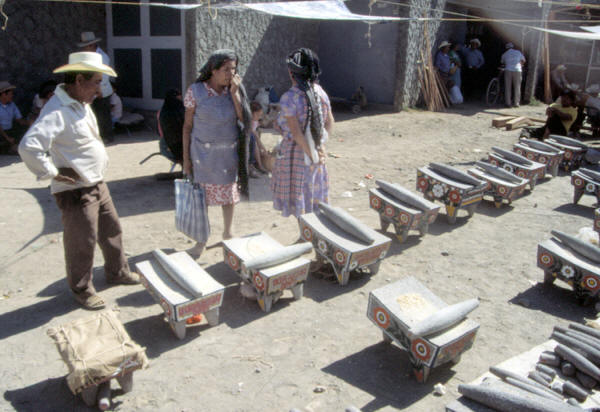
PHOTO CREDIT LITHIC CASTING
LAB'S COLLECTION OF ORIGINAL IMAGES
CLICK ON PICTURE FOR LARGER IMAGE
MANO AND METATE MARKET
MEXICO CITY, MEXICO
This picture shows a modern-day
market in Mexico City where metates and manos can still be
purchased. Although the use of stone corn grinders are fading, they
are still being used by many people living mainly in rural areas. |
|
|
Recent studies, in Mesoamerica, have provided some insight
into the average amount of time that women have spent grinding corn each day.
Grinding corn on a metate with a two handed mano is labor intensive.
Some households divided the work with different female members of the
family. Girls traditionally learned how to use a metate at a very young
age. An Aztec manuscript illustrates a mother teaching her thirteen year
old daughter to grind maize with a metate. Searcy (2011,
86) averaged the daily grinding time
estimates from five researchers (Chinas 1973,
Foster 1979, Lewis 1949, Smith 2003, and Vogt 1970).
The average daily time estimates vary widely, from a minimum of three
hours to a maximum of eight hours. Some factors that would change the
grinding time from person to person are age, proficiency, and type of
grinding stone used. Searcy's study of four Maya women in Guatemala
resulted in an average time of 4.8 hours of grinding time per day for a
family of five. His data shows that, "grinding maize was an activity
that potentially occupied a third of the day of Mesoamerican women." |
|
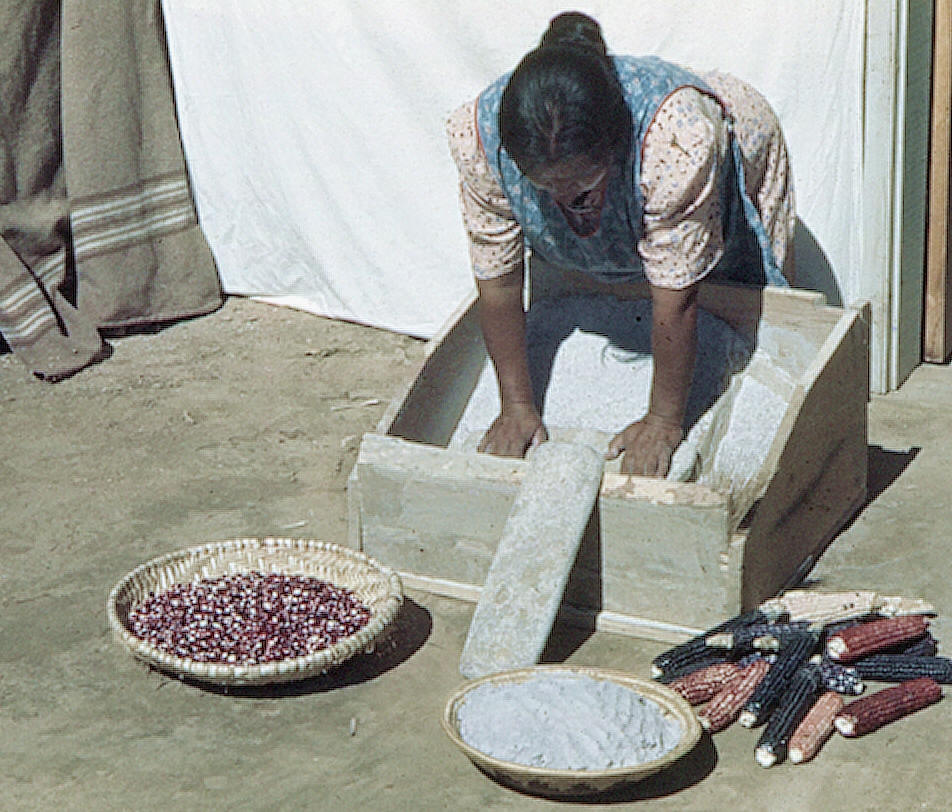
PHOTO CREDIT, ED SHAW, LITHIC CASTING
LAB'S COLLECTION OF ORIGINAL IMAGES
NAVAHO WOMAN GRINDING CORN
NEW MEXICO (1960's)
This picture was taken
sometime in the 1960's at one of the pueblos in New Mexico. It shows a
Navaho woman demonstrating the use of a metate and mono. One of the
baskets in front contains processed corn that's been ground to a
flour-like consistency. An extra flat-style mano is leaning against the
front of the grinding box. |
|
|
In the past, there has been some concern that grinding
stones haven't received the attention they should. But, in recent years,
there does seem to be more interest in them, especially in the area of
starch analysis. One of their drawbacks for study has been their large
bulky size. For example, two of the examples pictured in this report
from Illinois together weigh 122 pounds. So they are difficult to transport and store. In fact,
Searcy (2011), comments how they've been described as a pain in the
backside. He reports that they have often ended up as doorstops in museums. |
|
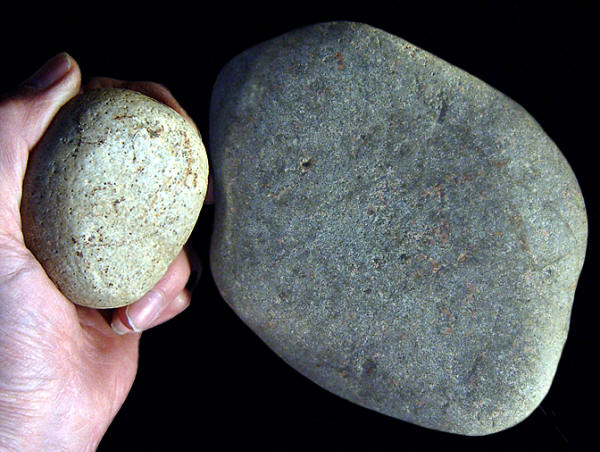
SIMPLE GRINDING STONE & MANO
MADISON COUNTY, ILLINOIS
Both of these grinding
tools were found on a site in Madison County, Illinois. The lower
grinding plate is slightly concave from the action of grinding. Both of
these tools show little or no shaping except for grinding wear. The
earliest grinding stones are simple unaltered pebbles. Hunter/gathers
began using naturally shaped stones, with a flat surface. One handed
manos are the earliest forms of upper grinders used. |
|
|
The best tool that archaeologists currently have
to study grinding stones is the ability to identify different types of
starch by microscopic analysis of surface residue. Rough grinding
surfaces are ideal locations for recovering samples of plant residues. It's been known
for 150 years that starch granules can be identified to specific plants.
Australia, China, Ecuador, Japan, New Guinea, and Israel are some of the
countries reporting the use of starch identification on ancient
grinding stones. Starch granules have been identified from a wide range
of different types of plants, such as, Manioc, banana, water chestnut,
palm, and walnut plus the more common cereal grains like corn, barley,
wheat, and oats. In Queensland, Australia starch from grinding stones
were identified as two different kinds of walnut. In Ecuador, the
identification of maize starch on grinding stones date the domestic use
of corn to between 5300 to 4960 cal years before present. In northern China at the Shizitan site cluster, 23,000 to 19,500 year old grinding stones
contained starch from grasses, beans, yams, and snakegourd roots. Plant
starch residue has been reported from grinding stones as early as 30,000
years ago. |
|

PHOTO CREDIT LITHIC CASTING
LAB'S COLLECTION OF ORIGINAL IMAGES
COMPUTER ALTERED IMAGE
GRINDING STONES
INDONESIA
Both of these grinding
plates and mano were collected somewhere in Indonesia and were made by
craftsmen who specialized in making grinding tools. They are
believed to be several hundred years old. |
|
|
Grinding stones were mainly used to process food. But
evidence shows they were also used to process non-food items such as
clay for ceramic containers, temper for clay used as a binder, paint pigments
and lime. Nonetheless, food processing was still their main purpose. The
Maya used them to grind Maize (corn) but also use them for many other
types of foods such as cacao, beans, squash seeds, tomatoes, coffee,
sugar, salt, and chilies. |
|
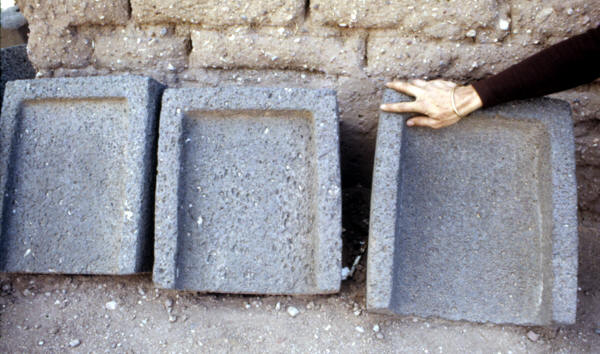
PHOTO CREDIT LITHIC CASTING
LAB'S COLLECTION OF ORIGINAL IMAGES
TROUGH METATES
BANDELIER NATIONAL MONUMENT--1976
NEW MEXICO
These three excellent
examples of trough metate grinding stones were found on the site of Bandelier
National Monument. Their principle use was for grinding corn. They were
made sometime between 1150 and 1550 by early Pueblo people. Trough
metates are reported to be the most efficient style of grinding stone. |
|
|
The use of grinding stones, to process food, predates the
development of farming. People who were living a hunting and gathering
lifestyle began to develop traditional food grinding technologies by
30,000 years ago. A grinding stone made of basalt was found on the
ancient site of Abu-Hureyra in Syria that dates to about 11,200 years
before present. The Ohalo II site in the sea of Galilee in Israel
produced a basalt grinding stone that dates to 23,000 years ago. In
Australia the oldest grinding stones are reported from Cuddie Springs,
in New South Wales, at 30,000 years ago. Another site, in southern Japan
called Nishitaragasako, produced grinding stones that date to sometime
between 32,000 and 29,000 years ago. |
|

PHOTO CREDIT LITHIC CASTING
LAB'S COLLECTION OF ORIGINAL IMAGES
CLICK ON PICTURE FOR LARGER IMAGE
METATES, MANOS, & MORTARS
CASA GRANDES
NORTHWESTERN MEXICO
STATE OF CHIHUAHUA
This picture was taken in
1973 on the ancient site of Casa Grandes in northwestern Mexico. The
artifacts appear to be either metates, manos, pestles, and mortars.
Most of these tools were used to process food by crushing and grinding.
The Casa Grandes site is one of the largest and most complex
archaeological
sites in the region. The earliest settlement dates to about 1130.
The site then developed into multistoried dwellings by about 1350 and was
abandoned by 1450. |
|
|
Grinding stones were
developed in different forms all over the world. But the basic technique
was fundamentally the same everywhere. The process involves two stones, a lower stone and an
upper stone. The lower stone was either small enough to be portable or
incorporated into a layer of bedrock. Some of the names they have been
referred to are grinding stones, quern stones, grinding slabs, milling
stones, metates, morahs, and bedrock metates. The upper stone was either small
and held in one hand or large and used with both hands. They are
referred to as hand stones and manos. Roller pestle is a name often used
by collectors. A third style of grinder consists of two round discs that
is turned by hand on a spindle and is called a rotary quern. |
|
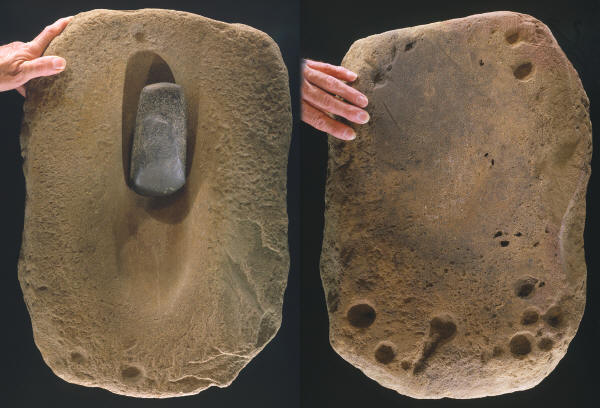
CLICK ON PICTURE FOR LARGER IMAGE
GRINDING STONE
SOUTHERN ILLINOIS
This very large grinding stone was found on a site in southern
Illinois, possibly in Calhoun County. It's one of the largest stone
tools that has been found in this area. It was apparently used for
multiple purposes. The long narrow groove on one side may have been
used to grind axes. But a large shallow concave area on the other
side may have been used for grinding food materials. The small
circular concavities along the edges may have been used to crack
nuts. This sandstone grinder weighs 76 lbs. and measures 20 3/8
inches (51.7cm) long, 15 inches (38.1cm) wide and 5 inches (12.7cm)
thick. |
|
|
Grinding stones were made
from many different types of stones depending on local sources. Each
type of stone has unique properties that will determine how effective it
will be for processing food.
For example, a smooth stone will not grind as well as a rough stone and
stones that wear quickly will release larger amounts of stone particles into the
food that can effect dental health. The most common stones used in Mesoamerica before European contact
were granite, rhyolite, andesite, quartzite, sandstone, and limestone.
The most common stone used to make modern grinding stones is vesicular (contains
tiny holes) granite. Studies show
that this type of stone lasts the longest. |
|
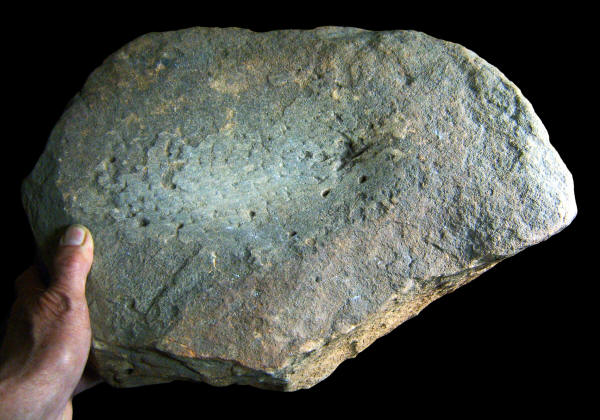
LARGE SANDSTONE GRINDING PLATE
SOUTHERN ILLINOIS
This sandstone grinding
stone might be referred to as a basin type grinding stone. It was found
on a site in southern Illinois. It shows
considerable wear but it still has a lot of use left in it. It's made of
fine grained sandstone and measures 16 inches (40.6 cm) long and weighs
46 pounds. |
|
|
Metate craftsmen are called metateros in Mexico and in some
countries farther south. They quarry the stone and manufacture both the
metates and manos. Before the use of explosives, the fire technique was
used to quarry the stone. Boulders were fractured by covering them with
grass and weeds and setting them on fire. Throwing water on the hot
surface fragmented the stone into usable pieces. Hampton (1999) also reported the same
quarrying technique by the Dani in Irian Jaya on the Island of New
Guinea. Modern-day metateros use metal tools to finish shaping their
rough quarried stone into metates. They use various sizes of iron
hammers, chisels, and adzes to complete a process that was once
accomplished with stone tools. |
|

PHOTO CREDIT LITHIC CASTING
LAB'S COLLECTION OF ORIGINAL IMAGES
BANGLADESH WOMAN WINNOWING RICE
PEOPLE'S REPUBLIC OF BANGLADESH
(1960's)
This picture shows a
Bangladesh woman in the process of wind winnowing rice. The technique
was developed by ancient cultures to separate the grain from the chaff.
Bangladesh is the eighth most populated country in the world and is much
smaller than Kansas. |
|
|
There may not be as many different styles of grinding
stones as stars in the sky but, when looking at them in a world
perspective, there are a lot of them. Hunter/gathers began using naturally shaped
stones, with a flat surface, for grinding. Over time, with the
development of farming communities, grinding stones evolved into more
complex forms that were manufactured by specialized craftsmen. Most
grinding stones did not have any support legs. Support leg styles range
from having one large pedestal leg to others that
have two wide legs, three legs and some have four. The metate grinding
stones of Mesoamerica are rectangular in shape. The most efficient style
are the trough metates that have built-in rectangular basins. Studies
show they could grind more grain per unit of time than basin or
flat/concave metates. The most efficient stone grinders are rotary. They
were particularly well established in parts of Asia and Europe. Earliest
examples from China date to 2,200 years ago. They are often referred to
as rotary querns and consist of two disc shaped stones, one on top of
the other. The top stone is turned by hand on a spindle and is perforated
with a hole that feeds in the grain. |
|
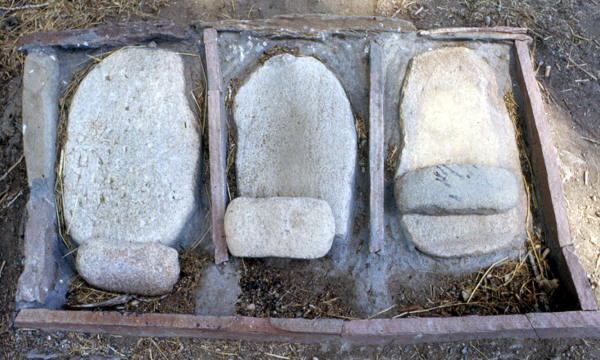
PHOTO CREDIT LITHIC CASTING
LAB'S COLLECTION OF ORIGINAL IMAGES
MANOS AND METATES
AZTEC RUINS NATIONAL MONUMENT
NORTHWESTERN NEW MEXICO
This picture was taken in
1973 of a display of simple grinding stones on the site of Aztec Ruins
National Monument. The display appears to be outside for hands-on
demonstration. The stones are cemented into place.
The Aztec Ruins National Monument was established in 1923.
It's situated along the Animas River in Aztec, New Mexico. The site
contains the ruins of multistoried dwellings built by Ancestral Pueblo
Indians. The west ruin once had more than 500 rooms. The site was
established sometime in the 12th century and was abandoned by about
1300. The Aztec Ruins site is about 2 miles (3.2 km) long and 1 mile
(1.6 km) wide in size. |
|
|
It's interesting to note that grinding stones were not the
healthiest way to process food. Even though they were generally made
from hard igneous rocks like granite or basalt they still wore down. The
health issue involves the amount of grit that was introduced into the
food being ground. Examination of the skeletal remains of many ancient
societies around the world, where stone grinders were used, indicate a
damaging effect on dental health. The addition of small stone particles
into food produced a secondary grinding effect that wore away tooth
enamel. The end result was loss of teeth and other related dental
illness at an early age. For example, the teeth of ancient Egyptians
show this type of wear pattern. Their average age is reported to have
been between 34 and 38 years. |
|

PHOTO CREDIT
LITHIC CASTING LAB'S COLLECTION OF ORIGINAL IMAGES
COMPUTER ALTERED IMAGES
"WORN-OUT" TROUGH METATE
PUEBLO BONITO
CHACO CANYON
NORTHERN NEW MEXICO
This picture
shows a trough style metate that was used until the stone was worn
through. Wouldn't be interesting to know how many bushels of corn was
processed. This picture was taken in 1973 at Pueblo Bonito.
Pueblo Bonito is the largest building in the Chaco Culture
National Historical Park in northern New Mexico. There are an estimated
650 to 800 rooms contained within the site. Pueblo Bonito was occupied
by ancestral Pueblo people between the years 828 and 1126. Deforestation
and drought are the two main reasons why they only occupied the site for 300
years. |
|
|
Another health issue, that grinding stones are responsible
for, are
wear and tear on the bones of people who have used them. History
records that grinding food was traditionally done by women. The fact
that the work was labor intensive is supported by the study of skeletal
remains. Skeletons that were studied on the 9,500 year old Syrian site
of Abu Hureyra show evidence of osteoarthritis and injuries to the toes,
knees, hips and lower back. These types of injuries were almost
exclusive to the bones of females. They are thought to have developed
from repetitive work in a kneeling position. In-other-words the type of
work that would involve the use of grinding stones. |
|

PHOTO CREDIT
LITHIC CASTING LAB'S COLLECTION OF ORIGINAL IMAGES
HOGAN DIORAMA
DOMESTIC NAVAJO KITCHEN SCENE
MUSEUM OF NEW MEXICO
This picture shows a portion of the
interior of a Navajo house in New Mexico. The scene is actually a
diorama museum display. A common and standard variety of metate can
be seen to the left, along with a two-handed mono and, what appears to be,
ground corn. These types of simple metates are still in use is some
areas today. |
|
|
Old taboos and Folkloric beliefs, concerning grinding stones,
are still respected in some areas. Some Maya traditions in Guatemala
relate such ideas as, "if you leave a metate out under the stars or the
moon, it will break" or "if you leave it out in the sun it will become
dull." Another belief is that "comparing a metate or mano to other
metates and manos will cause them to break." Other examples are, "a man
stepping over a metate may cause only female offspring and the reverse
for the woman," Eating while grinding may cause illness or injury to
children," and "a man touching a metate just after a woman has been
grinding may cause only female offspring," These accounts and others
suggest a belief that metates have a certain amount of spirit power.
Especially when accounts describe the metate as being able to "see" the
stars, if it's taken outside the house at night. |
|

PHOTO CREDIT GEORGE CRAWFORD & COMPUTER
ALTERED BY PETE BOSTROM
GRINDING PLATE & VERY LARGE MANO
BANDELIER NATIONAL
MONUMENT---NOV. 12, 1976
NEW MEXICO
This picture was taken in
1976 at Bandelier National Monument in New Mexico. It shows a
demonstration of the use of a metate and a two handed mano, although the
mano seems to be almost as large as the demonstrator! |
|
|
Although most grinding stones seem worn and rough, in
their day they would have been one of the most important tools in a
household. They represent a system of processing food that was hard
work. In today's modern society, drudgery is the word that comes to
mind. But as one Maya woman said, "the metate is the
reason we are alive." That pretty much says it all. |
|
"REFERENCES"
1976, Briuer, "Chevelon Canyon And
Cayote Creek Pueblo, Arizona, USA, 700-8700BP," American Antiquity.
1979,
Eddy, Frank W., "Metates & Manos. The Basic Corn Grinding Tools Of
The Southwest."
1983,
Spink, Mary Louise, "Metates As Socioeconomic Indicators During The
Classic Period At Copan, Honduras," (A Thesis In Anthropology).
1984, Hoffman, Michael A., "Egypt Before The Pharaohs, The
Prehistoric Foundations Of Egyptian Civilization.
1999, Hampton, O. W., "Culture Of Stone, Sacred And Profane Uses Of
Stone Among The Dani."
2000, Palka, Joel W. "Historical Dictionary Of Ancient
Mesoamerica."
2001,
Dubreuil, Laure, "Functional Studies Of Prehistoric Grindingstones,
A Methodological Research," Bulletin du Centre de Recherche
Francais A Jerusalem.
2001, Misra, V. N., "Prehistoric Human Colonization Of India,"
Journal Of Biosciences, Vol. 26, No. 4, Indian Academy Of Sciences.
2003, "On The Earliest Evidence For Rice Cultivation In China,"
The Institute Of Archaeology, Chinese Academy Of Social Sciences.
2006, Lucas, Adam, "Wind, Water, Work: Ancient And Medieval Milling
Technology."
2006, Zeder, Melinda A., "Documenting Domestication, New Genetic And
Archaeological Paradigms."
2008, Zarrilli, Sonia, Pearsall, Deborah M., Raymond, J. Scott,
Tisdale, Mary Ann, & Quon, Dugane, "Directly Dated Starch Residues
Document Early Formative Maize (Zea mays L.) In Tropical Ecuador,"
Proceedings Of The National Academy Of Sciences, Vo. 105, No. 13.
2011, Haslam, Michael, "Mountains And Molehills: Sample Size In
Archaeological Microscopic-Tool Residue Analysis,"
Archaeological Science Under A Microscope: Studies In Residue And
Ancient DNA Analysis In Honour Of Thomas H. Loy, Australian
National University Press Library, Terra Australis 30.
2011, Field, Judith, Cosgrove, Richard, Fullagar, Richard, & Lance,
Braddon, "Starch Residues On Grinding Stones In Private Collections: A
Study Of Morahs From The Tropical Rainforests Of NE Queensland,"
Archaeological Science Under A Microscope: Studies In Residue And
Ancient DNA Analysis In Honour Of Thomas H. Loy, Terra Australis
30.
2011, Searcy, Michael T., "The Life-Giving Stone, Ethnoarchaeology
Of Maya Metates."
2011, Gremillion, Kristen J., "Ancestral Appetites: Food
In Prehistory."
2013, Liu, Li, Bestel, Sheahan, Shi, Jimming, Song, Yanhua, and
Chen, Xingcan, "Paleolithic Human Exploitation Of Plant Foods During The
Last Glacial Maximum In North China," Proceedings Of The National
Academy Of Sciences, Vol. 110 No. 14.
2014, Cook, Scott, "Land, Livelihood, and Civility in Southern
Mexico: Oaxaca Valley Communities In History"
|
|
RECENT
LISTINGS HOME
ORDERING |